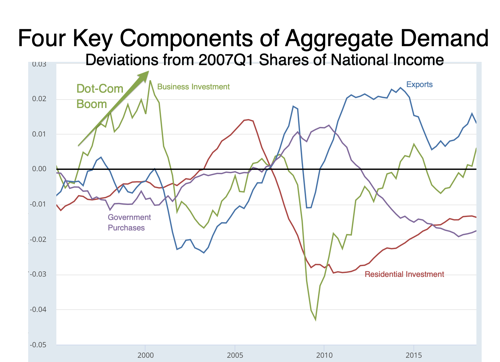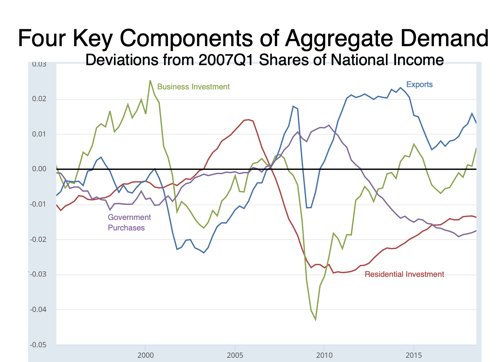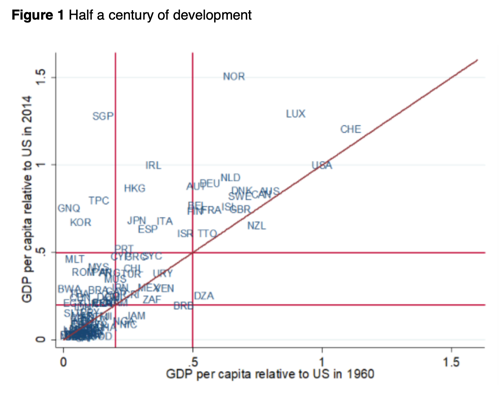J. Bradford DeLong's Blog, page 164
June 17, 2019
Adam Kotsko's mode of discourse is well outside my normal...
Adam Kotsko's mode of discourse is well outside my normal wheelhouse, but I do think that this is important. It is generally a mistake in America to think that religious arguments will persuade anyone of anything political or moral. In America, at least, religion tends to act as a righteousness multiplier rather than a set of principles and ideas that can be used for persuasion and to get peoplle to think reflectively:
Adam Kotsko: The Political Theology of Trump: "This brings us to a scriptural parallel that evangelicals themselves have drawn with Trump: Cyrus the Great, the Persian Emperor who allowed Israelite priestly elites to settle back in the Promised Land.... The Prophet Isaiah sings this pagan ruler���s praises, even calling him God���s ���anointed���... ���Messiah��� in Hebrew or ���Christ��� in Greek���and promising divine assistance in his ongoing conquest.... IT���S THE BIBLICAL VERSION of 'only Nixon can go to China'. Only a pagan ruler who knows nothing of the God of Israel... can restore the righteous remnant to the Promised Land.... The use of an ignorant, pagan ruler makes the divine agency unmistakable from the Israelite perspective. How could it be more clear that God is really controlling events when his purpose is fulfilled without the involvement of any conscious human intention? My mom suggested that something similar was at play on that painful phone call the morning after the election, when she wondered aloud whether the improbable events that made Trump President against the American people���s will spoke of a divine intention.... There is not much that any of us can do to convince evangelical Trump supporters that their anointed one is an antichrist...
#noted
Liveblogging: The Anglo-Saxon Chronicle: Life of Jesus

The Anglo-Saxon Chronicle (J.A. Giles and J. Ingram trans.): Life of Jesus: "A.D. 1. Octavianus reigned fifty-six winters; and in the forty-second year of his reign Christ was born. Then three astrologers from the east came to worship Christ; and the children in Bethlehem were slain by Herod in persecution of Christ...
...A.D. 3. This year died Herod, stabbed by his own hand; and Archelaus his son succeeded him. The child Christ was also this year brought back again from Egypt.
A.D. 6. From the beginning of the world to this year were agone five thousand and two hundred winters.
A.D. 11. This year Herod the son of Antipater undertook the government in Judea.
A.D. 12. This year Philip and Herod divided Judea into four kingdoms.
A.D. 16. This year Tiberius succeeded to the empire.
A.D. 26. This year Pilate began to reign over the Jews.
A.D. 30. This year was Christ baptized; and Peter and Andrew were converted, together with James, and John, and Philip, and all the twelve apostles.
A.D. 33. This year was Christ crucified; about five thousand two hundred and twenty six winters from the beginning of the world...
#liveblogging #history #anglosaxonchronicle
The New York Times decides to mark Father's Day by misogy...
The New York Times decides to mark Father's Day by misogynistic wife-slagging! As I said, moral fault attaches to those who support or work for the New York Times: Ana Mardoll: "Obviously they want rage clicks, but this is such a fascinating misuse of a common phrase. 'More than their fair share"' necessarily implies that someone else is slacking. Since marriages often have only two people in them, that leaves... the wife...
New York Times Opinion: "On Father���s Day, the honor of dads must be defended, says @DouthatNYT. Yes, fathers spend less time doing household chores. But when you add up housework, paid work and childcare, married fathers today are doing even more than their fair share...
#noted
June 16, 2019
Eric Chyn, Samantha Gold, and Justine S. Hastings: The Re...
Eric Chyn, Samantha Gold, and Justine S. Hastings: The Returns to Early-Life Interventions for Very Low Birth Weight Children: "Administrative data from Rhode Island... regression discontinuity design... 1,500-gram threshold for Very Low Birth Weight (VLBW) status.... Threshold crossing causes more intense in-hospital care, in line with prior studies. Threshold crossing also causes a 0.34 standard deviation increase in test scores in elementary and middle school, a 17.1 percentage point increase in the probability of college enrollment, and 66,997 decrease in social program expenditures by age 14. We explore potential mechanisms driving these impacts...
#noted
How Lenny Mendonca actually found time to teach this cour...
How Lenny Mendonca actually found time to teach this course while coordinating California's economic development plans is beyond me: but he is a very, very high-energy person: Lenny Mendonca: Business and Public Policy Perspectives on US Inequality: "Inequality in the United States���Definition and Facts. Inequality in the United States���Why Do Businesses and MBA Students Care? Housing and Transportation. Place-Based Policies. Race and Inequality. Opportunity and Early Education. Higher Education. Immigration (and Effects on Other American Workers). Low-wage Workers. Tax Policy���The 1%. Work in the Future and Universal Basic Income...
#noted
Weekend Reading: History and Myth
In the minds of the monks who wrote the Anglo-Saxon Chronicle, the baptism of Ethelbert King is a historical event on a par with Cynric King having Woden, father-god of the Aesir and high drighten of Valhalla, as his great8-grandfather: The Anglo-Saxon Chronicle A: 552: "This year Cynric fought against the Britons at the place which is called Searo-byrig [Old Sarum], and he put the Britons to flight. Cerdic was Cynric's father, Cerdic was the son of Elesa, Elesa of Esla, Esla of Gewis, Gewis of Wig, Wig of Freawin, Freawin of Frithogar, Frithogar of Brond, Brond of Beldeg, Beldeg of Woden. And Ethelbert, the son of Ermenric was born; and in the thirtieth year of his reign he received baptism, the first of the kings in Britain...
#weekendreading #books
Liveblogging: The Anglo-Saxon Chronicle: Julius Caesar

The Anglo-Saxon Chronicle (J.A. Giles and J. Ingram trans.): Julius Caesar: "Sixty winters ere that Christ was born, Caius Julius, emperor of the Romans, with eighty ships sought Britain. There he was first beaten in a dreadful fight, and lost a great part of his army. Then he let his army abide with the Scots, and went south into Gaul. There he gathered six hundred ships, with which he went back into Britain...
...When they first rushed together, Caesar's tribune, whose name was Labienus, was slain. Then took the Welsh sharp piles, and drove them with great clubs into the water, at a certain ford of the river called Thames. When the Romans found that, they would not go over the ford. Then fled the Britons to the fastnesses of the woods; and Caesar, having after much fighting gained many of the chief towns, went back into Gaul...
#liveblogging #history #anglosaxonchronicle
More than Two Decades of Macroeconomic History Through the Lens of Four Key Components of Aggregate Demand
It is remarkable the extent to which you can tell the story of the U.S. macroeconomy over the past twenty-five years through the reactions of four components of aggregate demand to policies and shocks:
The dot-com boom unleashed by the Clinton deficit-reduction program and high-tech innovation.
The dot-com bust.
The housing boom.
The successful rebalancing of aggregate demand���housing sits down, while exports and business investment stand up as money flows are successfully redirected.
The Fed well behind the financial-stability curve: the financial crisis and the collapse.
Inadequate recovery: The Geithner Treasury and the Obama White House's failure to do anything to promote a recovery of residential construction.
Inadequate recovery: Republican (and Obama) fiscal austerity.
Inadequate recovery: Bernanke's highly premature taper tantrum.
The Trump rebound.
Dot-Com Boom:

Dot-Com Bust:

Housing Boom:

Rebalancing Near Full Employment:

Financial Crisis and Crash:

Inadequate Recovery: Construction Stagnation:

Inadequate Recovery: Fiscal Austerity:

Inadequate Recovery: Bernanke's Taper Tantrum

Trump Rebound


#forecasting #macro #monetarypolicy #fiscalpolicy #highlighted
This File: https://www.bradford-delong.com/2019/06/recent-macroeconomic-history-through-the-lens-of-four-key-components-of-aggregate-demand.html
Edit This File: https://www.typepad.com/site/blogs/6a00e551f08003883400e551f080068834/post/6a00e551f0800388340240a4b440fa200b/edit
Forecasting: https://www.bradford-delong.com/forecasting.html
Monetary and Fiscal Policy and Theory https://www.bradford-delong.com/monetary-policy-and-theory.html
Reda Cherif and Fuad Hasanov: Principles of Industrial Policy: Weekend Reading

Reda Cherif and Fuad Hasanov: Principles of Industrial Policy: "The return of the policy that shall not be named: The 'Asian miracles' and their industrial policies are often considered as statistical accidents that cannot be replicated.... We can learn more about sustained growth from these miracles than from the large pool of failures.... Industrial policy is instrumental in achieving sustained growth. Successful policy uses state intervention for early entry into sophisticated sectors, strong export orientation, and fierce competition with strict accountability...
...Achieving sustained growth over long periods of time has been an elusive 'holy grail' of macroeconomics. In the past 50 years developing economies have taken different paths. A few���such as the 'Asian miracles' of Hong Kong, South Korea, Singapore, and Taiwan ��� are catching up swiftly with the advanced economies, and some forging ahead. But many are falling behind, to use the terminology of Abramovitz (1986).��
The empirical evidence shows that the odds for poor or middle-income countries to reach high-income status within two generations are very low (Cherif and Hasanov, forthcoming). Between 1960 and 2014, fewer than 10% of economies (16 out of 182 in the sample) reached high-income status. There were three categories of those that made it: Asian miracles, countries that discovered large quantities of oil, and those that benefited from joining the European Union.
We argue (Cherif and Hasanov 2019)����that one cannot ignore the pre-eminent role of industrial policy in the development of the Asian miracle countries as well as for Japan, Germany, and the US before them. The industrial policies pursued by the Asian miracles have a lot in common. This suggests that the standard 'growth policy recipe' of tackling only government failures (improving macro-stability, enforcing property rights, providing basic infrastructure and education, and so on) may not be enough to create advanced economies in a short period of time. Instead, recent research suggests that industrial policy may benefit economic development too (Rodrik 2019).
Happy countries are alike: Distilling useful lessons from country experiences is daunting. Without natural experiments it is hard to disentangle the role of policy from luck, or from exogenous factors. Using a stylised model we can show that it is not easy to distinguish between luck and policy in the countries that have diverged.��
And with many exogenous factors that affect growth, failures may arise from completely different sources of bad luck. Including these countries may add more noise than signal when we try to establish what determines growth. In contrast, having been spared bad luck, countries that succeeded in catching up possess a lot of valuable information about the common policies that they implemented. To paraphrase Tolstoy: happy economies are all alike; every unhappy economy is unhappy in its own way (Cherif and Hasanov 2019).��
Learning more from miracles than failures can be justified empirically as well. The evidence suggests that long-term cross-country growth follows a power law distribution, indicating that important information lies in the tail rather than in the average. This approach contrasts with the standard empirical approach that emphasises averages such as growth regressions. In other words, according to the Nobel laureate in physics Phil Anderson:
Much of the real world is controlled as much by the tails of distributions as [by] means or averages��� by the exceptional not the common place; by the catastrophe, not the steady drip ��� we need to free ourselves from ���average��� thinking. (Ramalingam 2013)
Technology and innovation policy: The lessons of the Asian miracle countries in their pursuit of industrial policy to achieve high-income status suggest three key principles that constitute what we call 'true industrial policy', which can essentially be described as Technology and Innovation Policy (TIP). These principles are:
State intervention to fix market failures that preclude the emergence of domestic producers in sophisticated industries early on, beyond the initial comparative advantage.
Export orientation, in contrast to the typical failed industrial policy of the 1960s���1970s, which was mostly import substitution industrialisation (ISI).
The pursuit of fierce competition both abroad and domestically with strict accountability.��
The contrasting cases of Proton in Malaysia and Hyundai in South Korea vividly illustrate of these principles at work:
Proton. The Malaysian government established a national car company, and had an ambitious plan to create a local supplier cluster. The venture was successful in building managerial and engineering skills. But Proton did not manage to export in substantial quantities, and an innovative automotive cluster did not develop (Cherif and Hasanov, forthcoming).��
Hyundai. By contrast, Hyundai succeeded in creating a global brand. A push to export and a bet on several chaebols to simultaneously develop cars were key elements in its success (Cherif and Hasanov, forthcoming). South Korean automakers vigorously pursued a 'move first, then learn and adjust' approach to exporting.��
This drive to export could be attributed to a large extent to state policies (Woo 1991). In exchange for state support given by making loans with low and often negative real interest rates, chaebols had to quickly gain market shares abroad. If they failed to reach export targets, senior management would often be dismissed, and so accountability was strongly enforced. The pressure to export and compete forced Hyundai to increase R&D effort and technology upgrades. By 1991, it had produced its own-design engine, and its first electric car. The state���s bet on several chaebols to develop the auto industry allowed restructuring when needed, and few of them succeeded.
Both the state and the market have their roles when implementing TIP. The state steers labour and capital into activities the market would not necessarily undertake (Cherif et al. 2016a, 2016b). But exposure to competition, market-signal-based decision-making, and an autonomous private sector are also vital.��
A three-gear approach to TIP: The state sets the level of its ambition���that is, the level of sophistication of the new sectors and the degree of domestic ownership of technology. It then implements policies while imposing accountability and being able to adapt as conditions change. Ambition, Accountability, and Adaptability are the 'triple A' of the 'leading hand of the state' (Cherif and Hasanov 2019).��Mediocre growth is not necessarily fatal. It depends on the right policies, and the level of the gear selected:
Low gear. This is a snail crawl approach that results in relatively lower growth, and relative stagnation.��We argue that the standard growth recipe such as improving business environment, institutions, and infrastructure, preserving macro-stability, investing in education, and minimising government interventions constitute only the lowest gear of TIP.��These policies mostly fix government failures, but not necessarily market failures, especially in the development of sophisticated sectors beyond comparative advantage. They may not be sufficient to sustain high long-term growth.
Middle gear. This is a leapfrog approach, mostly relying on attracting FDI in sophisticated industries, or climbing the quality ladder around existing industries (Malaysia and Chile are two examples). This may provide relatively high growth, leading to the middle-income status, but it is unlikely to lead to high-income status within two generations.��Standard policies to attract FDI and develop industries around comparative advantage sectors may result in leapfrogging.
High gear. The Asian miracle countries���the highest gear���use a moonshot approach, in which the aim is to create competitive domestic firms in frontier technologies.��The state intervenes to fix market failures and develop sophisticated sectors, domestic or homegrown technology. It creates conditions for high and sustained long-term growth.
A technological leap: Overall, the extent of the technological leap to sophisticated industries early, and the extent of the technology creation by domestic firms, determines the success of long-term growth. Countries that manage this process would have a high chance of becoming high-income countries in a relatively brief period. We argue that the Asian miracles implemented these principles, offering clues as to what other countries could do to follow in their footsteps....
#weekendreading #economicgrowth #industrialpolicy
J. Bradford DeLong's Blog
- J. Bradford DeLong's profile
- 90 followers



